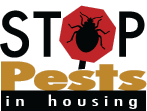Fabric Pests
How to deal with fabric pests
 |
|
Carpet beetle adult. Photo by Gary Alpert, Harvard University, Bugwood.org. |
 |
|
Varied carpet beetle larva. Photo by Joseph Berger, Bugwood.org. |
 |
|
Casemaking clothes moth larva. Clemson University - USDA Cooperative Extension Slide Series, Bugwood.org. |
Got 'em? Time to spend some quality time with the vacuum. Move furniture around and be sure to get the dust bunnies. They don't like sharing their space, so rotate through wearing your sweaters whenever it's cold. If you need to store stuff, make sure it's clean first and keep the humidity down. Mothballs are stinky to us, but most pests don't care. Cedar chests and closets only work for the first few years. If the infestation's bad, throw stuff out. Or get it professionally cleaned. But tell them why you need help so they take pains to keep the pests from other people's things.
What they look like
Though both moths and beetles can eat fabric, it's their larvae—the squishy stage in their life cycle—that do the damage. Clothes moth larvae are creamy white with black heads. They're rarely seen, since they wrap themselves in silken feeding tubes. Adults are pale tan with satiny sheen; flutter in dimly lit closets (If you see one, start checking your woolens for damage.) Multiply quickly in warm (over 75° F) humid weather, especially where there's poor air circulation. Carpet and hide beetle larvae are hairy, often dark golden colored. Adults are round, black, or variegated with black, cream, white, or yellow.
Where they live
They live where they eat and your house could be a buffet: woolens; oriental rugs; horsehair stuffed sofas; perhaps perspiration-stained cotton, linen, or rayon; pet hair that's collected in corners or the cracks of your floorboards; even a dead mouse in the wall or bird in the chimney can be a food source.
What they do
Make holes in silk blouses, woolen sweaters, fur coats, or carpets. Be suspicious if your furs start to shed.
Resources
Management of Pest Insects in and around the home
See results from the Northeastern IPM Center's resources database.
